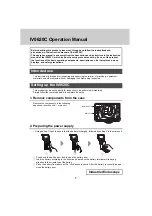
Hints and Tips
Page 43
lobby say do the slowest reading first, in case it takes forever.
At extreme conditions, for example 5°C and 80 %RH ambient this may be a problem.
It really does not matter which one you choose. Just wait for the readings to stabilise.
The same considerations apply when the ambient RH changes. Allow 5 or 10 minutes for
the moisture in the cup walls to reach its new equilibrium concentration when you reset
the RH Set point. You will know this when the calibration plate readings are stable.
When calibrating you have the option of curve-fitting after you have only measured four
positions, but we strongly recommend you always do all 6. Only in special situations
should you accept less - for instance if you find a plate position which is impossibly slow,
or if you are certain that the range you are working in is very small and will not exceed
the shorter calibration range.
Avoid leaving the calibration plate (or a leaf) in the head when it is not cycling (e.g. when
the Main Menu is displayed). The cup RH will rise to a high level, and it will take a further
few minutes to stabilise when cycling is resumed.
CHOICE OF CUP
This depends on the shape, size and texture of leaf surfaces you are trying to measure.
The leaf must cover the whole of the cup aperture -you can view the cup through the
rubber pad to check this. In general, the slotted cup is preferable because it covers a
larger area. Leaf stomata can be very unevenly distributed.
The other consideration is contact between the leaf and the rubber seal around the cup
rim. The circular cup shape might be better for working between the veins of some
leaves.
LEAF HANDLING
With the prospect of making hundreds of stomatal measurements in a session, it is
worthwhile to optimise your technique so that you take readings as quickly as possible.
It is generally better to accept a reading after four or five cycles even though some drift
is still apparent, rather than hang on for a possibly more accurate reading. The double
beep gives you an indication of <2% change, but you may prefer to override this as you
gain experience - or if you can't stand the noise! It also frees you from watching the
display continuously.
The only caution to this procedure is when the new leaf temperature is substantially
different from the previous one. You will probably see the cup-leaf
δ
T moving, and you
should wait until it stabilises. The AP4 automatically compensates for non-isothermal
conditions, but the correction will be inaccurate if the measured δT is lagging behind the
true value.
Summary of Contents for AP4
Page 1: ...User Manual for the AP4 Porometer Version 4 Delta T Devices Version 4 0 ...
Page 21: ...CALIBRATION Page 21 ...
Page 23: ...CALIBRATION Page 23 INSTALL CALIBRATION FLOW CHART ...
Page 30: ...HOW TO READ Page 30 ...
Page 32: ...HOW TO READ Page 32 READINGS CYCLE FLOW CHART ...
Page 34: ...HOW TO READ Page 34 STORE READINGS FLOW CHART ...
Page 35: ...REVIEW Page 35 REVIEW No editing can be done and no settings changed within REVIEW ...
Page 38: ...OUTPUT TO COMPUTER Page 38 TYPICAL PRINT OUT OF DATA 17 ...
Page 49: ...Layout and Control Page 49 ...
















































